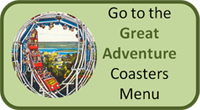
The Swiss firm of Bolliger & Mabillard had developed a sterling
reputation for innovative, smooth, and reliable coasters during the
1990's, and in the coaster war, they were called on by parks to keep
coming up with "the next big thing". In 2002, the new twist on
coaster development was the Flying Coaster which had simultaneously been
engineered by other manufacturers like Vekoma and Zamperla, though the
design was perfected by B&M.
|
|
|
 |
| |
|
|
 |
 |
 |
| |
|
|
 |
 |
 |
| |
|
|
 |
 |
 |
| |
|
|
 |
Six Flags has always
been an innovator, introducing the latest in coasters and rides each
season. After the first flying coaster was introduced by Vekoma in 2000,
new versions were added to Six Flags parks in 2001. The Vekoma design
suffered from prolonged downtime, and though the gimmick of flying was a
huge attraction, they looked for a better version.
The new flying
coaster design from Bolliger & Mabillard was introduced in 2002 in the
U.S. at Six Flags Over Georgia with the installation of Superman:
Ultimate Flight. This was the prototype for the two Superman: Ultimate
Flight coasters added in 2003 at Six Flags Great America and Six Flags
Great Adventure. |
 |
| |
|
 |
 |
| |
|
|
 |
 |
 |
| |
|
|
 |
With the success of
Superman: Ultimate Flight at Six Flags Over Georgia, plans were quickly
made to clone the ride at Great Adventure and Great America, with both
parks choosing ride locations and then at the last moment revising the
locations of the rides, with both parks settling on locations at the
front of the park, near the entrance, in a former area of parking lot.
While Six Flags Great America removed the Shockwave coaster
(which was originally to have been placed at Great Adventure in 1988)
after public outcry over the removal of the Whizzer Coaster, Great
Adventure's version was relocated so it wouldn't require tree removal,
making the approval easier. |
 |
| |
|
 |
 |
| |
|
|
 |
 |
 |
| |
|
|
 |
 |
 |
| |
|
|
 |
The original plan called for removal of the Viper roller coaster and the
new Superman ride being located over the creek between Rolling Thunder
and Runaway Mine Train. The logistics of the construction meant moving
it to a flat and clear piece of land was a cost saving as well as time
saver. |
 |
| |
|
|
 |
 |
 |
| |
|
|
 |
Click
Below to View Time Lapse Construction
 |
| |
 |
| |
|
|
 |
 |
 |
| |
|
|
 |
 |
 |
| |
|
|
| |
|
|
 |
 |
 |
| |
|
Superman: Ultimate Flight was one of the first coasters added by Six
Flags to utilize computer animation and renderings for its press
materials. This was ironic since it was a nearly identical clone of the
ride built one year earlier at Six Flags Over Georgia.
|
| |
|
|
 |
Click Below to View Computer Animation of Superman Ultimate
Flight
 |
| |
|
|
| |
|
|
| |
|
|
 |
Promotion of the new coaster
continued into the winter with the second season of Winter Lights
featuring a Superman display. The construction site was easily viewed
during Winter Lights as the path of the displays wound through the main
parking lot, with the parking area for the Holiday Village being located
right next to the construction fence. |
| |
|
|
| |
|
|
 |
 |
 |
| |
|
|
 |
Construction on
Superman began in late summer of 2002, with the area of the parking lot
where the new coaster was being built getting closed off with a
construction fence, relocating the lanes of traffic further into the
parking lot. A criticism of many of the roller coasters built by Six
Flags in that era was they were "parking lot coasters", taking over what
had once been parts of the parking lots of the parks, and in some cases
simply installed over the parking lot striped pavement.
It is true that may
parks did this (Scream at Six Flags Magic Mountain and Medusa at Six
Flags Discovery Kingdom were prime examples), and Great Adventure had
done the same thing when Sarajevo Bobsled was installed in 1984. Unlike those other coasters, when
Superman: Ultimate Flight was built, the first stage of construction was
removing all the asphalt from the site right down to the
underlying dirt. |
 |
| |
|
 |
 |
| |
|
 |
 |
| |
|
|
 |
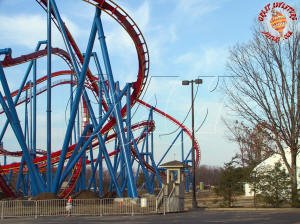 |
 |
| |
|
|
 |
 |
 |
| |
|
|
 |
 |
 |
| |
|
|
 |
Once the site was
cleared, the footings went in and the grading of the site took place,
creating the pit for the pretzel loop. The footers were each unique,
with a very specific pattern of bolts for the ride supports. A set of
steel plates was part of the initial shipments of materials, each
numbered to correspond with the supports. The plates were templates for
the bolts to be set in the concrete and align the ride supports with the
precision of a Swiss watch. |
 |
| |
|
 |
 |
| |
|
|
 |
 |
 |
| |
|
|
 |
 |
 |
| |
|
|
 |
Through the cold,
snowy winter the ride structure came together. By early spring and the
park's opening the ride structure was complete, though the station
building and car shed were still a work in progress. There was
still much work to be done with a new fence and landscaping needed
around the ride, sidewalks for the ride entrance and exit, and even an
entrance through the white "bubble building" for accessing the ride from
the park.
Over the first weeks of the season, progress continued
with the final pieces coming together as testing of the roller coaster
began. An elaborate steel fence in Superman blue was erected
around the ride's perimeter, with fast growing white pine trees planted
all along the edge of the parking lot to create a visual screen.
Eventually, the Superman "S" shields were added to the sections of fence
to help dress up the ride area. |
 |
| |
|
 |
 |
| |
|
 |
 |
| |
|
 |
 |
| |
|
|
 |
The new roller
coaster was quite impressive to guests entering the park, dominating the
view. The bright red and yellow track with the blue supports stood out
beautifully against the white building behind it. Like all B&M coasters,
it was an impressive piece of sculpture as well as being an exciting new
ride.
After the sidewalks were installed for the ride entrance
and exit, the infield of the ride was leveled and planted with grass.
Chain link fences with barbed wire were installed for the rides low
flying areas with limited clearances. |
 |
| |
|
 |
 |
| |
|
|
 |
 |
 |
| |
|
|
 |

A big part of the
construction of Superman: Ultimate Flight was building the entrance to
the ride. The entrance and exit paths had to be rooted directly through
the park's original Administration Building, which was a large white
tent-like structure originally at the far edge of the park. The
"bubble building" had been used for years as a warehouse and then as the
Alcatraz: The Ride upcharge attraction. When Superman was added,
Alcatraz was relocated to the far end of the building.
|
 |
| |
|
 |
 |
| |
|
|
 |
 |
 |
| |
|
|
 |

The plaza in front of
the entrance had been the site of the often-relocated Scrambler ride as
the G-Force Centrifuge. That plaza area got a full makeover with a large
portal to serve as a backdrop for the sign. The area in front received
fresh concrete for the creation of a huge Superman symbol at the
entrance.
 |
 |
| |
 |
| |
|
|
 |
 |
 |
| |
|
|
| |
|
|
 |
 |
| |
|
|
|
By mid-April,
Superman: Ultimate Flight was ready to make its debut to the public, and
the media day event to announce the ride's opening was held on April
17th. Events for the media included a "Search for Heroes" essay contest.
|
| |
|
|
| |
|
|
 |
 |
 |
| |
|
|
 |
Superman opened to
the public on Friday, April 18th. The landscaping was still a work in
progress at the time, with the ground seeded for the grass, but the
seeds not having germinated yet, leaving it looking like a desert
beneath the coaster. The bright colors of the ride really stood out
against the bare earth, but with the warming spring weather, the grass
grew in relatively quickly, looking quite full by Memorial Day weekend
and the unofficial start of summer. |
 |
| |
|
 |
 |
| |
|
|
 |
 |
 |
| |
|
|
 |
 |
 |
| |
|
|
 |
 |
 |
| |
|
|
 |
Theme elements for
Superman: Ultimate Flight were relatively simple with cutouts featuring
Superman's foes lining the entrance pathway. Outside the ride entrance
panels illustrated Superman's abilities and what made Superman super.
Much of the material used for the ride station and theme elements
was simple, industrial material. This created a vaguely futuristic look.
All of the colors were very bright and all primary colors and shades of
grey. This was designed to be reminiscent of the colors found in the
Superman comic books. |
 |
| |
|
|
 |
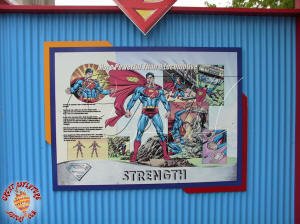 |
 |
| |
 |
| |
|
|
 |
Technical Specifications
|
Manufacturer: |
|
Bolliger & Mabillard - Monthey,
Switzerland |
| Model: |
|
Flying Coaster |
| Maximum
Height: |
|
115 feet |
| First
Drop: |
|
100 feet |
| Ride
Elements: |
|
1 Pretzel-shaped inverted loop |
|
|
1 Spiral, 1 Horseshoe, 1 In-line roll |
| Track
Length: |
|
2,759 feet |
| Ride
Time: |
|
Nearly 3 minutes |
| Vehicles: |
|
Three trains of 7 cars holding 4 riders |
|
|
28 riders per train total |
| Safety
Systems: |
|
Computer controlled fail-safe brakes |
|
|
Padded shoulder/breast harnesses and lap
bars |
| Capacity: |
|
1500 riders per hour |
|
| |
 |
| |
|
|
 |
 |
 |
| |
|
|
 |
 |
 |
| |
|
|
 |
Superman: Ultimate
Flight at Six Flags Great Adventure and its twin which was built at the
same time at Six Flags Great America both used the same basic design as
the original Superman: Ultimate Flight at Six Flags Over Georgia that
had opened the year before. Unlike the Georgia version, the new models
featured a single track station instead of dual tracks. Because of
this, they also featured only two trains instead of the three trains on
the original.
The two train versions each had trains of 8 cars,
for a capacity of 32 riders per train versus the 7 car trains in the
original with only 28 riders per train. The additional capacity
per train theoretically brought the capacity to nearly the same as the
dual station version, but with fewer moving parts making the new
versions cheaper and simpler to maintain.
The photo booth for
Superman had been the photo booth for The Chiller and was moved across
the park. |
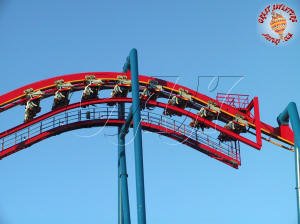 |
| |
|
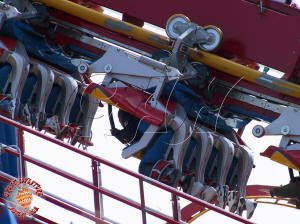 |
 |
| |
|
 |
 |
| |
|
|
 |
 |
 |
| |
|
|
 |
The exit for the ride ran back
through the empty "bubble building", with space left purposely to build
a shop at the ride exit. Budget and time meant the shop would be delayed
one season. |
 |
| |
|
|
 |
 |
 |
| |
|
|
 |
 |
 |
| |
|
|
 |
The flying concept was a huge
success with the public who had never seen anything like it. Despite the
relatively small size of the coaster, the thrill level was high from the
lift hill with nothing below it, to the huge pretzel loop and its
incredible G-forces to the flying sensation and twists in the tracks.
Lines were huge and filled the entire queue area on many days. The
switchback sections were built with sunshade structures, but the
coverings for those structures didn't arrive until late summer. |
 |
| |
|
|
 |
 |
 |
| |
|
|
 |
 |
 |
| |
|
|
 |
For many coaster
enthusiasts Superman was something of a disappointment since it was a
copy of the original rather than being something custom designed and
unique. The general public seems to have cared less, and lines have
continued to be long for the coaster even eight seasons after its
introduction. The size of those lines helped greatly to contribute to
the success of Six Flags Great Adventure's new Fast Pass (now Flash
Pass) system as people were willing to pay to get past the huge lines
without having to wait. |
 |
| |
|
 |
 |
| |
|
|
 |
 |
 |
| |
|
|
 |
 |
 |
| |
|
 |
To accommodate the
Fast Pass riders, an additional stairway was added to the opposite end
of the station from the regular line.
With the long lines that often formed for the ride, it became evident
that shade structures were needed to keep the guests in the slow moving
line comfortable standing in what was once part of the parking lot.
Superman-red canopy frames with blue canvas tarps were built over the
main queue houses which helped keep down the temperatures. Various
types of adjoining snack stands have also been installed through the
years to keep riders cool and refreshed.
The blue aluminum fencing, while attractive, has had to withstand the
punishment of bored waiting guests. The plastic caps atop each
picket have almost all been removed.
|
| |
|
 |
 |
| |
|
 |
 |
| |
|
|
 |
 |
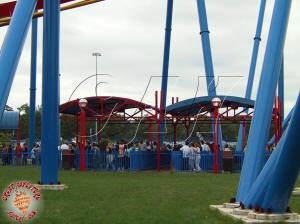 |
| |
|
|
| 2004: A Store is Born |
| |
|
|
 |
For the 2004 season,
the Daily Planet Gifts shop was added at the exit from the ride. The gift
shop was planned but not built for 2003 and made its debut in the spring
of 2004 when the park opened for the season.
Over the years the Daily Planet has offered guests to purchase Super
Hero themed trinkets and gifts featuring not only Superman but the
entire Justice League cast. |
 |
| |
|
 |
 |
| |
|
|
| |
|
|
 |
 |
 |
| |
|
 |
 |
| |
|
|
 |
To help deal with
lines in the park, DJ booths were added to the line for Nitro and
Superman. The DJs played music and interacted with the crowds to help
entertain the people in line for an hour or more at a time.
The
design of the ride offers a unique challenge in the event of an
evacuation of the ride with ride operators required to go through a
multi step process to unlock the cars from the flying position and
manually crank the seats back into a more comfortable upright position.
Luckily this doesn't happen very often.
|
 |
| |
 |
| |
|
|
 |
 |
 |
| |
 |
| |
|
|
 |
 |
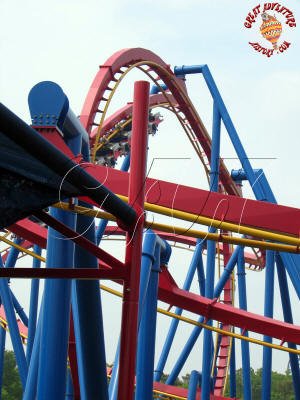 |
| |
|
|
 |
 |
 |
| |
|
|
 |
 |
 |
| |
|
|
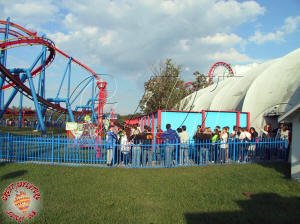 |
One of the most
remarkable parts of the Superman: Ultimate Flight experience is the fact
that guests have to walk through the center of the ride to reach the
station. This builds anticipation as trains fly past the queue
filled with screaming riders and then weave in and out through the
structure. This also provides amazing views of the ride allowing
photographs of almost every angle of the ride along its course. |
 |
| |
|
 |
 |
| |
|
|
 |
 |
 |
| |
|
|
 |
 |
 |
| |
|
|
 |
One of the most
impressive parts of Superman is the mechanics of the ride's system for
raising and lowering the cars for loading and unloading. The trains are
designed with hinges that allow the seats to fold up under the track,
with riders facing towards the ground. This folding is done with a set
of rails along the sides of the station that a set of guide wheels on
each row of seats rides in. The rails are raised and lowered by a set of
motors above the track that activate weighted bell cranks.
Lowering the rails pushes the guide wheels down and pivots the seats
into the flying positions, and raising the rails lowers them into the
unload/load position. Once the seats are pivoted up, a double set of
locking pins holds the seats in place, not allowing them to drop until
they are unlocked again either when powered in the station or by
manually unlocking them in case of emergency. |
 |
| |
|
 |
 |
| |
|
 |
 |
| |
|
 |
 |
| |
|
|
 |
 |
 |
| |
|
|
 |
 |
 |
| |
|
|
 |
 |
 |
| |
|
|
Click Below to View a Ride Video
 |
 |
| |
 |
| |
|
|
 |
 |
 |
| |
|
|
 |
Superman has had a
somewhat troubled operational record since it opened, with its first of
a kind wireless control system often giving false readings to the ride's
control system. The false readings would often cause one of the two
trains to be pulled off the tracks in the middle of the day which causes
delays in operations as well as reducing capacity. Many of those bugs
have been worked out over the seasons, but there are still occasional
hiccups that cause delays in operations. |
 |
| |
|
 |
 |
| |
|
 |
 |
| |
|
|
 |
 |
 |
| |
|
|
 |
 |
 |
| |
|
|
 |
 |
 |
| |
|
|
 |
One of the rare sights to see is
the procedure to take guests off the ride's lift hill in the event of a
power failure or a mechanical failure of the lift chain. To remove
guests a motorized platform can be brought up beneath the train,
allowing the guests to be unlocked from their restraints and lowered
onto the platform which lets them get to the stairs running up the left
side of the lift hill. This is a time consuming process and luckily is a
very rare occurrence. |
 |
| |
|
|
 |
 |
 |
| |
|
 |
 |



